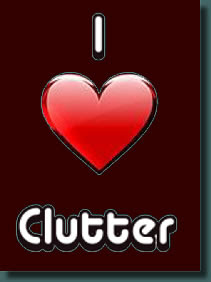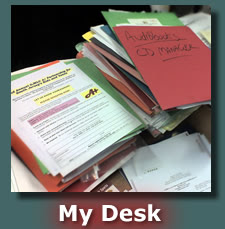 I was gratified this morning to read this article in the New York Times by Sara Rimer: An orderly office? That’s personal. The article reports on Lisa Whited, an interior designer who specializes in adapting work spaces to the needs, habits, and goals of their users. She’s not your typical “get rid of the clutter now!” organizer. Instead of boilerplate suggestions for getting organized, Whited begins her jobs by interviewing clients to determine their specific work habits and styles.
I was gratified this morning to read this article in the New York Times by Sara Rimer: An orderly office? That’s personal. The article reports on Lisa Whited, an interior designer who specializes in adapting work spaces to the needs, habits, and goals of their users. She’s not your typical “get rid of the clutter now!” organizer. Instead of boilerplate suggestions for getting organized, Whited begins her jobs by interviewing clients to determine their specific work habits and styles.
What particularly caught my attention was that after interviewing her client (the author of the article), Whited surmised that she was the kind of person who needed to see things in front of her or else she forgot she had them, so putting things away in a filing cabinet might not be an effective organizational strategy. Reading those words, I wanted to reach into the paper (well, into the laptop–I read the paper online now) and wrap my arms around Whited and thank her for validating my life.
Out of Sight Out of Mind
See, I’m an out-of-sight out-of-mind kind of guy. Just today I came to work without my wallet (it was “put away” in a drawer), and twice last week I came to work without my phone (it was charging in another room.) I pretty much have to organize my morning so that anything that requires my attention — phone, wallet, pants (well, maybe not pants, I’ve effectively habitualized that one) — needs to be visible to me when I’m leaving the house.
 Likewise, with work. My whole organizational strategy is about keeping important things in my field of vision. If I’m not looking at it, it may as well not exist. (Note to friends and family: Apologies for being out of touch but I forgot that you existed.)
Likewise, with work. My whole organizational strategy is about keeping important things in my field of vision. If I’m not looking at it, it may as well not exist. (Note to friends and family: Apologies for being out of touch but I forgot that you existed.)
Since there’s only so much that I can keep on my desk, it’s generally not possible or practical to have too many physical reminders (notes, papers, etc.) in my field of vision. That’s why I rely heavily – VERY heavily – on text message and email reminders which I liberally set for myself using Google Calendar. (Note to Google Calendar: I’m not saying I’d leave my wife for you, but I admit we have something very special.)
Everyone I’ve ever worked with has learned that I will not see a message unless it’s placed on my chair seat. I’ve learned that if I need to do something first thing in the morning, I leave a note on my keyboard where I can’t miss it. Before text message reminders came into my life I relied heavily on taping notes to the doorknob at home (“remember to go to meeting in Trenton this morning!”)
While paper reminders in my field of vision can help, they also have their downside. One piece of paper can be accidentally placed over another piece of paper. Or it can blow away. Or it can have coffee spilled on it. For these reasons, I’ve actually arranged my work life to be as free from paper as possible. There’s probably the equivalent of 20 reams of paper sitting on my desk right now, most of it in colored folders. 98% of it has been generated by someone else and given to me at a meeting or conference. If it’s something I think I may ever want to reference again I’ve trained myself to scan it into PDF so I have an electronic copy. One great benefit of putting everything into electronic format is that, thanks to Google Desktop Search, I can find anything I ever “touched” on my computer — email, website, pdf, etc. — immediately, and sometimes quicker!
Don’t Judge My Piles!
 While these piles on my desk may look like a mess to the outside observer, I like having them visible because they remind me to look through them now and then and pull out little tidbits. A note jotted in the margin a of a Powerpoint handout from a conference presentation or a handout from a workshop I’ve given (and completely forgotten about) can trigger new insights and connections, or give me a new perspective on a problem I’m dealing with. I like the serendipity of it. It’s both relaxing to me and stimulating.
While these piles on my desk may look like a mess to the outside observer, I like having them visible because they remind me to look through them now and then and pull out little tidbits. A note jotted in the margin a of a Powerpoint handout from a conference presentation or a handout from a workshop I’ve given (and completely forgotten about) can trigger new insights and connections, or give me a new perspective on a problem I’m dealing with. I like the serendipity of it. It’s both relaxing to me and stimulating.
Perhaps one reason most “get organized” books fail to help people like me is that they’re written by people who are not at all like me—they’re written by people who equate neatness with organization, and assume that a neat orderly environment is an a priori good and an end unto itself. I think the authors of these books are people who feel stressed out when they see a lot of stuff so, by gum, they’re not only gonna put away their stuff, they’re gonna make sure MY stuff is put away too!
But they fail to appreciate that many people are NOT like them—we don’t function best when everything is “put away”, nor are we particularly stressed by clutter. In fact, I’m generally oblivious to clutter. I don’t even see the piles of paper on my desk.
Organization Is Not an End Unto Itself
This is what I want to tell the neatniks, declutterers, straighteners, and put-awayers of the world: Organization is a tool. It is a means to an end but it is NOT an end unto itself. The end is effectiveness. Happiness. Comfort. Flow. And I need lots of stuff around in my visual field to achieve those states. So thanks for trying to help, but my brain isn’t wired like yours. So if I need help getting organized I’ll call Lisa Whited because she understands. It’s personal.
Links:
